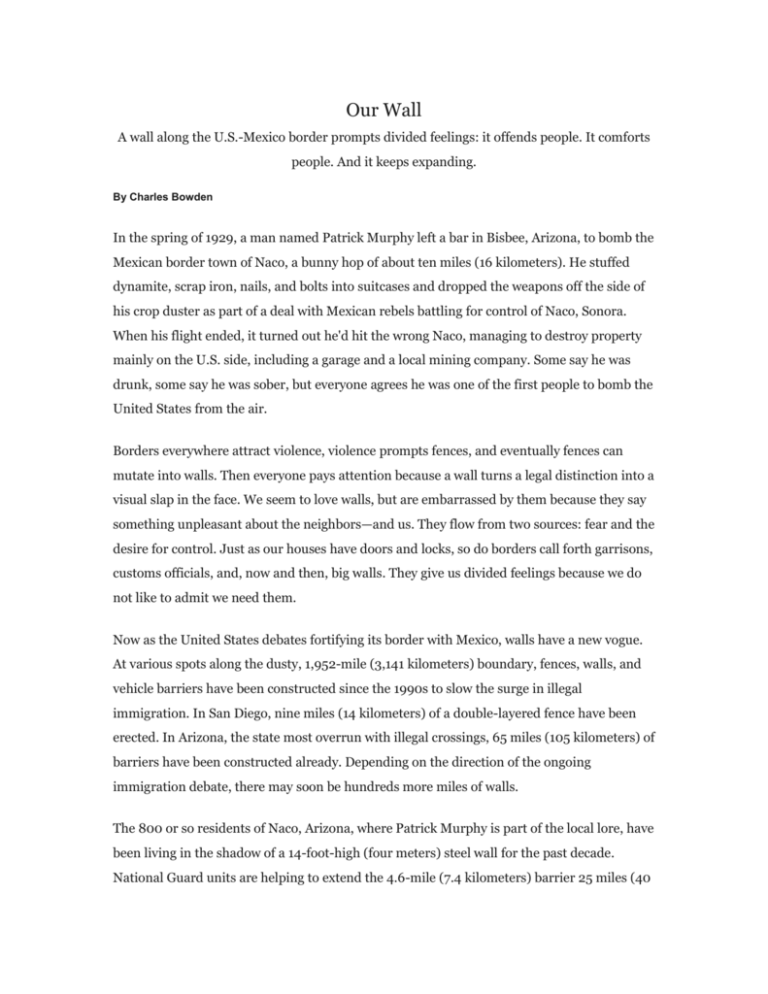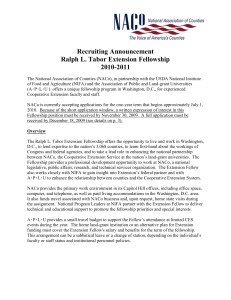Our Wall A wall along the U.S.-Mexico border prompts divided
advertisement

Our Wall A wall along the U.S.-Mexico border prompts divided feelings: it offends people. It comforts people. And it keeps expanding. By Charles Bowden In the spring of 1929, a man named Patrick Murphy left a bar in Bisbee, Arizona, to bomb the Mexican border town of Naco, a bunny hop of about ten miles (16 kilometers). He stuffed dynamite, scrap iron, nails, and bolts into suitcases and dropped the weapons off the side of his crop duster as part of a deal with Mexican rebels battling for control of Naco, Sonora. When his flight ended, it turned out he'd hit the wrong Naco, managing to destroy property mainly on the U.S. side, including a garage and a local mining company. Some say he was drunk, some say he was sober, but everyone agrees he was one of the first people to bomb the United States from the air. Borders everywhere attract violence, violence prompts fences, and eventually fences can mutate into walls. Then everyone pays attention because a wall turns a legal distinction into a visual slap in the face. We seem to love walls, but are embarrassed by them because they say something unpleasant about the neighbors—and us. They flow from two sources: fear and the desire for control. Just as our houses have doors and locks, so do borders call forth garrisons, customs officials, and, now and then, big walls. They give us divided feelings because we do not like to admit we need them. Now as the United States debates fortifying its border with Mexico, walls have a new vogue. At various spots along the dusty, 1,952-mile (3,141 kilometers) boundary, fences, walls, and vehicle barriers have been constructed since the 1990s to slow the surge in illegal immigration. In San Diego, nine miles (14 kilometers) of a double-layered fence have been erected. In Arizona, the state most overrun with illegal crossings, 65 miles (105 kilometers) of barriers have been constructed already. Depending on the direction of the ongoing immigration debate, there may soon be hundreds more miles of walls. The 800 or so residents of Naco, Arizona, where Patrick Murphy is part of the local lore, have been living in the shadow of a 14-foot-high (four meters) steel wall for the past decade. National Guard units are helping to extend the 4.6-mile (7.4 kilometers) barrier 25 miles (40 kilometers) deeper into the desert. The Border Patrol station is the biggest building in the tiny town; the copper roof glistens under the blistering sun. In 2005, a pioneering bit of guerrilla theater took place here when the Minutemen, a citizen group devoted to securing the border, staked out 20 miles (32 kilometers) of the line and patrolled it. Today about 8,000 people live in Naco, Sonora, on the Mexican side of the metal wall that slashes the two communities. Only a dirt parking lot separates the Gay 90s bar from the Naco wall. Inside, the patrons are largely bilingual and have family ties on both sides of the line. Janet Warner, one of the bartenders, has lived here for years and is one of those fortunate souls who has found her place in the sun. But thanks to the racks of stadium lights along the wall, she has lost her nights, and laments the erasure of the brilliant stars that once hung over her life. She notes that sometimes Mexicans jump the new steel wall, come in for a beer, then jump back into Mexico. The bar began in the late 1920s as a casino and with the end of Prohibition added alcohol. The gambling continued until 1961, when a new county sheriff decided to clean up things. On the back wall are photographs of Ronald and Nancy Reagan when they'd stop by on their way to a nearby Mexican ranch. The bar is one of only a handful of businesses left. The commercial street leading to the border is lined with defunct establishments, all dead because the U.S. government sealed the entry to Mexico after 9/11 and rerouted it to the east. Leonel Urcadez, 54, a handsome man who has owned the bar for decades, has mixed feelings about the wall. "You get used to it," he says. "When they first built it, it was not a bad idea—cars were crossing illegally from Mexico and the Border Patrol would chase them. But it's so ugly." The two Nacos came into being in 1897 around a border crossing that connected copper mines in both nations. By 1901 a railroad linked the mines. A big miners' strike in 1906, one cherished by Mexicans as foreshadowing the revolution in 1910, saw troops from both nations facing each other down at the line. The town of Naco on the Mexican side changed hands many times during the actual revolution—at first the prize was revenue from the customs house. Later, when Arizona voted itself dry in 1915, the income came from the saloons. Almost every old house in Naco, Arizona, has holes from the gun battles. The Naco Hotel, with its three-foot (one meter) mud walls, advertised its bulletproof rooms. The boundary between Mexico and the United States has always been zealously insisted upon by both countries. But initially Mexicans moved north at will. The U.S. patrols of the border that began in 1904 were mainly to keep out illegal Asian immigrants. Almost 900,000 Mexicans legally entered the United States to flee the violence of the revolution. Low population in both nations and the need for labor in the American Southwest made this migration a non-event for decades. The flow of illegal immigrants exploded after the passage of the North American Free Trade Agreement in the early 1990s, a pact that was supposed to end illegal immigration but wound up dislocating millions of Mexican peasant farmers and many small-industrial workers. The result: Naco was overrun by immigrants on their way north. At night, dozens, sometimes hundreds, of immigrants would crowd into motel rooms and storage rental sheds along the highway. The local desert was stomped into a powder of dust. Naco residents found their homes broken into by desperate migrants. Then came the wall in 1996, and the flow of people spread into the high desert outside the town. The Border Patrol credits the wall, along with better surveillance technology, with cutting the number of illegal immigrants captured near Naco's 33-mile (53 kilometers) border by half in the past year. Before this new heightening of enforcement, the number caught each week, hiding in arroyos thick with mesquite and yucca, often exceeded the town's population. At the moment, the area is relatively quiet as "coyotes," or people smugglers, pause to feel out the new reality, and the National Guard has been sent in to assist the Border Patrol. At the nearby abandoned U.S. Army camp, the roofs are collapsing and the adobe bricks dribble mud onto the floor. Scattered about are Mexican water bottles—illegals still hole up here after climbing the wall. Residents register a hodgepodge of feelings about the wall. Even those who have let passing illegal immigrants use their phones or given them a ride say the exodus has to stop. And even those sick of finding trash in their yards understand why the immigrants keep coming. "Sometimes I feel sorry for the Mexicans," says Bryan Tomlinson, 45, a custodial engineer for the Bisbee school district. His brother Don chimes in, "But the wall's a good thing." A border wall seems to violate a deep sense of identity most Americans cherish. We see ourselves as a nation of immigrants with our own goddess, the Statue of Liberty, a symbol so potent that dissident Chinese students fabricated a version of it in 1989 in Tiananmen Square as the visual representation of their yearning for freedom. Walls are curious statements of human needs. Sometimes they are built to keep restive populations from fleeing. The Berlin Wall was designed to keep citizens from escaping from communist East Germany. But most walls are for keeping people out. They all work for a while, until human appetites or sheer numbers overwhelm them. The Great Wall of China, built mostly after the mid-14th century, kept northern tribes at bay until the Manchu conquered China in the 17th century. Hadrian's Wall, standing about 15 feet (5 meters) high, 9 feet (3 meters) wide, and 73 miles (117 kilometers) long, kept the crazed tribes of what is now Scotland from running amok in Roman Britain—from A.D. 122 until it was overrun in 367. Then you have the Maginot Line, a series of connected forts built by France after World War I to keep the German army from invading. It was a success, except for one flaw: The troops of the Third Reich simply went around its northwestern end and invaded France through the Netherlands and Belgium. Now tourists visit its labyrinth of tunnels and underground barracks. In 1859 a rancher named Thomas Austin released 24 rabbits in Australia because, he noted, "the introduction of a few rabbits could do little harm and might provide a touch of home, in addition to a spot of hunting." By that simple act, he launched one of the most extensive barriers ever erected by human beings: the rabbit fences of Australia, which eventually reached 2,023 miles (3,256 kilometers). Within 35 years, the rabbits had overrun the continent, a place lacking sufficient and dedicated rabbit predators. For a century and a half, the Australian government has tried various solutions: imported fleas, poisons, trappers. Nothing has dented the new immigrants. The fences themselves failed almost instantly— rabbits expanded faster than the barriers could be built, careless people left gates open, holes appeared, and, of course, the rabbits simply dug under them. In Naco all the walls of the world are present in one compact bundle. You have Hadrian's Wall or the Great Wall of China because the barrier is intended to keep people out. You have the Maginot Line because a 15-minute walk takes you to the end of the existing steel wall. You have the rabbit fences of Australia because people still come north illegally, as do the drugs. Perhaps the closest thing to the wall going up on the U.S.-Mexico border is the separation wall being built by Israel in the West Bank. Like the new American wall, it is designed to control the movement of people, but it faces the problem of all walls—rockets can go over it, tunnels can go under it. It offends people, it comforts people, it fails to deliver security. And it keeps expanding. Rodolfo Santos Esquer puts out EL MIRADOR, a weekly newspaper in Naco, Sonora, and he finds the wall hateful. He stands in his cramped office—a space he shares with a small shop peddling underwear—and says, "It looks like the Berlin Wall. It is horrible. It is ugly. You feel more racism now. It is a racist wall. If people get close to the wall, the Border Patrol calls the Mexican police, and they go and question people." And then he lightens up because he is a sunny man, and he says it actually hasn't changed his life or the lives of most people in town. Except that the coyotes now drive to the end of the wall before crossing. And as the wall grows in length, the coyotes raise their rates. Santos figures half the town is living off migrants going north—either feeding them and housing them or guiding them into the U.S. Passage to Phoenix, about 200 miles (320 kilometers) away, is now $1,500 and rising. He notes that after the wall went up in 1996, the migration mushroomed. He wonders if there is a connection, if the wall magically beckons migrants. Besides, he says, people just climb over it with ropes. Santos fires up his computer and shows an image he snapped in the cemetery of a nearby town. There, there, he points as he enlarges a section of the photo. Slowly a skull-shaped blur floats into view against the black of the night—a ghost, he believes. The border is haunted by ghosts—the hundreds who die each year from heat and cold, the ones killed in car wrecks as the packed vans of migrants flee the Border Patrol, and the increasing violence erupting between smugglers and the agents of Homeland Security. Whenever heat is applied to one part of the border, the migration simply moves to another part. The walls in southern California drove immigrants into the Arizona desert and, in some cases, to their deaths. We think of walls as statements of foreign policy, and we forget the intricate lives of the people we wall in and out. Emanuel Castillo Erúnez, 23, takes crime and car wreck photos for El Mirador. He went north illegally when he was 17, walked a few days, then was picked up and returned to Mexico. He sits on a bench in the plaza, shielded by a New York Yankees cap, and sums up the local feeling about the wall simply: "Some are fine with it, some are not." He thinks of going north again, but then he thinks of getting caught again. And so he waits. There is a small-town languor about Naco, Sonora, and the wall becomes unnoticeable in this calm. The Minutemen and National Guard terrify people. At the Hospedaje Santa María, four people wait for a chance to go over the wall and illegally enter the wealth of the United States. It is a run-down, two-story building, one of many boarding houses for migrants in Naco. Salvador Rivera, a solid man in his early 30s, has been here about a year. He worked in Washington State, but, when his mother fell ill, he returned home to Nayarit, Mexico, and is now having trouble getting past the increased security. He left behind an American girlfriend he can no longer reach. "For so many years, we Mexicans have gone to the U.S. to work. I don't understand why they put up a wall to turn us away. It's not like we're robbing anybody over there, and they don't pay us very much." But talk of the wall almost has to be prompted. Except for those engaged in smuggling drugs or people, border crossers in Naco, Sonora, continue to enter through the main gate, as they always have. They visit relatives on the other side, as they always have. What has changed is this physical statement, a big wall lined with bright lights, that says, yes, we are two nations. Jesús Gastelum Ramírez lives next door to the wall, makes neon signs, and looks like Willie Nelson. He watches people climb the wall and he understands a reality forgotten by most U.S. lawmakers—that simply to go through the wire instantly raises a person's income tenfold. Gastelum knows many of his neighbors smuggle people, and he understands. Until recently, a volleyball team from the Mexican Naco and a team from the U.S. Naco used to meet once a year at the point where the wall ends on the west side of town, put up a net on the line, bring kegs of beer, and play a volleyball game. People from both Nacos would stream out to the site and watch. And then the wall would no longer exist for a spell. But it always confronts the eye. Dan Duley, 50, operates heavy equipment and is a native of the Naco area. He was living in Germany after serving in the Air Force when the Berlin Wall came down, and he thought that was a fine thing. But here he figures something has to be done. "We need help," he says. "We're being invaded. They've taken away our jobs, our security. I'm just a blue-collar man living in a small town. And I just wish the government cared about a man who was blue." But then, as in many conversations on the border, the rhetoric calms down. Duley, along with many other Naco residents, believes the real solution has to be economic, that jobs must be created in Mexico. There is an iron law on this border: The closer one gets to the line, the more rational the talk becomes because everyone has personal ties to people on the other side. Everyone realizes the wall is a police solution to an economic problem. The Mexicans will go over it, under it, or try to tear holes in it. Or, as is often the case, enter legally with temporary visiting papers and then melt into American communities. Of the millions of illegal immigrants living in the United States, few would have come if there wasn't a job waiting for them. Over in Naco, Sonora, the final night of a fiesta is in full roar. Men drinking beer move by on horseback, groups of girls in high heels prance past. Nearby, folks play bingo, and in the band shell a group does a sound check for the big dance. Looming over the whole party is a giant statue of Father Hidalgo with his bald head and wild eyes. He launched the Mexican Wars of Independence in 1810. Two blocks away, the steel wall glows under a battery of lights. In the Gay 90s bar in Naco, Arizona, a quinceañera, the 15th-birthday celebration that introduces a young girl to the world, is firing up. There are 200 people in the saloon's back room, half from Mexico and half from the U.S. The boys wear rented tuxedo vests, the girls are dressed like goddesses. One man walks in with a baby in a black polka-dot dress with pink trim. The birthday girl, Alyssa, stands with her family for an official portrait. Walls come and go, but quinceañeras are forever, I say to the man with the baby. He nods his head and smiles. The steel barrier is maybe a hundred feet (30 meters) away. Outside in the darkness, Mexicans are moving north, and Border Patrol agents are hunting them down. Tomorrow, work will continue on the construction of the wall as it slowly creeps east and west from the town. Tourists already come to look at it. I have no doubt someday archaeologists will do excavations here and write learned treatises about the Great Wall of the United States. Perhaps one of them will be the descendant of a Mexican stealing north at this moment in the midnight hour.








